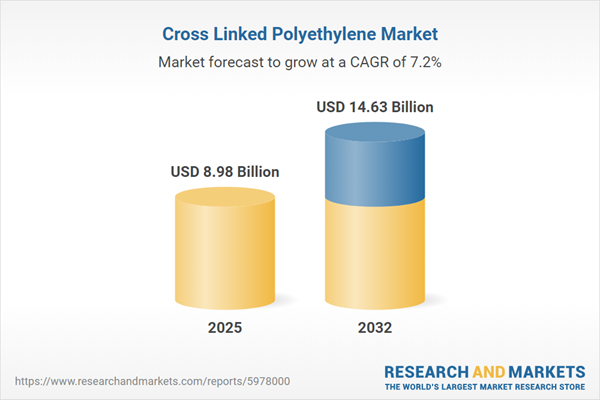Speak directly to the analyst to clarify any post sales queries you may have.
Cross linked polyethylene is increasingly central for senior decision-makers aiming to align material choices with fast-evolving compliance and sustainability priorities. This versatile polymer supports resilient infrastructure, enabling organizations to adapt to regulatory shifts and competitive market pressures.
Market Snapshot: Cross Linked Polyethylene Market Size & Growth
The global cross linked polyethylene market stands at a value of USD 8.38 billion and is projected to reach USD 8.98 billion by 2025, reflecting a robust compound annual growth rate (CAGR) of 7.21%. By 2032, industry forecasts indicate the market will be worth USD 14.63 billion. This trajectory is driven by rising infrastructure investments, mounting compliance needs, and organizational shifts favoring dependable, long-lasting materials. Industry leaders are proactively evolving product portfolios and supply chains to address sustainability and ensure responsiveness to new regulatory frameworks.
Scope & Segmentation of the Cross Linked Polyethylene Market
Effective segmentation enables B2B stakeholders to fine-tune strategy, procurement, and compliance efforts for the cross linked polyethylene market:
- Applications: Used in automotive, construction, electrical insulation, power cables, telecom, and networking—cross linked polyethylene delivers operational reliability where performance is critical.
- End Use Industries: Essential for continuous operation in sectors like automotive, transportation, electronics, energy, power, oil, and gas, this material underpins business continuity and risk mitigation.
- Cross Link Technologies: Incorporates peroxide, radiation, and silane cross-linking methods, giving organizations options to comply with various technical and regulatory norms regionally.
- Pressure Ratings: Available for low, medium, and high-voltage applications, the material supports safe use in utilities, electronic systems, and significant infrastructure projects.
- Material Types: Supplied as Type I and Type II, cross linked polyethylene lets companies align materials to specific industry requirements or certification benchmarks.
- Distribution Channels: Accessed through direct procurement, certified distributors, digital B2B platforms, and formal retail, it matches diverse sourcing and risk management strategies.
- Geographies: The market has global coverage across the Americas, Europe, Middle East, Africa, and Asia-Pacific, each region reflecting local investment climates, regulatory demands, and technology adoption rates.
- Companies Profiled: Profiles of major players include China Petroleum & Chemical Corporation, LyondellBasell, SABIC, ExxonMobil, Dow, INEOS, Formosa Plastics, Shell, Chevron Phillips Chemical, and Borealis AG.
Key Takeaways for Senior Decision-Makers
- Cross linked polyethylene sustains operational reliability and reduces long-term maintenance, supporting companies in critical infrastructure and industrial settings.
- Diverse cross-linking options allow businesses to optimize for region-specific compliance and performance objectives without sacrificing flexibility.
- B2B purchasing trends are shaped by local priorities: the Americas invest in expanding infrastructure, EMEA prioritizes regulatory alignment, and Asia-Pacific drives rapid adoption of material innovations.
- Rising sustainability requirements are encouraging organizations to focus on recyclability and supply chain traceability—factors directly impacting procurement decisions and supplier evaluations.
- Partnering with technology-forward suppliers enables agility in responding to new compliance rules and material science advancements.
- Flexible sourcing, leveraging both direct and distributor channels, increases resilience against supply disruptions in vital markets.
Tariff Impact on United States Supply Chains
Recent tariff adjustments prompt U.S. buyers of cross linked polyethylene to strengthen domestic manufacturing and prioritize localization. This approach secures essential procurement, maintains cost control, and ensures steady supply for uninterrupted operations in crucial sectors.
Methodology & Data Sources
This report synthesizes primary research and insights from industry strategists, materials specialists, and senior executive interviews. Quantitative findings are reinforced by patent reviews and vendor analysis, ensuring robust data for key B2B decision-makers.
Why This Cross Linked Polyethylene Market Report Matters
- Aligns cross-linking technology developments with shifting regulatory landscapes, enabling supply chain leaders to proactively address complex compliance issues.
- Delivers strategic recommendations to enhance investment outcomes, streamline operational strategies, and support growth initiatives across principal global markets.
- Supports sustainability and risk management programs by providing actionable insights on reliable sourcing and resilient supply chains.
Conclusion
Cross linked polyethylene serves as a foundation for resilient operations across industry segments and geographies. This analysis helps leaders anticipate change, manage compliance, and make timely procurement decisions as global market conditions develop.
Additional Product Information:
- Purchase of this report includes 1 year online access with quarterly updates.
- This report can be updated on request. Please contact our Customer Experience team using the Ask a Question widget on our website.
Table of Contents
3. Executive Summary
4. Market Overview
7. Cumulative Impact of Artificial Intelligence 2025
Companies Mentioned
The companies profiled in this Cross Linked Polyethylene market report include:- China Petroleum & Chemical Corporation
- LyondellBasell Industries N.V.
- Saudi Basic Industries Corporation
- ExxonMobil Chemical Company
- The Dow Chemical Company
- INEOS Group Holdings S.A.
- Formosa Plastics Corporation
- Royal Dutch Shell PLC
- Chevron Phillips Chemical Company LLC
- Borealis AG
Table Information
| Report Attribute | Details |
|---|---|
| No. of Pages | 199 |
| Published | November 2025 |
| Forecast Period | 2025 - 2032 |
| Estimated Market Value ( USD | $ 8.98 Billion |
| Forecasted Market Value ( USD | $ 14.63 Billion |
| Compound Annual Growth Rate | 7.2% |
| Regions Covered | Global |
| No. of Companies Mentioned | 11 |









